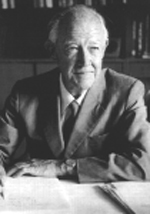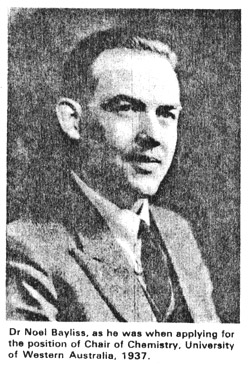


 Photo and © here. |
Noel Stanley Bayliss was born in Brisbane, Australia, in 1906. He entered the University of Melbourne in 1924, enrolling for a science course majoring in chemistry and metallurgy, though in his second year he switched to a joint major in chemistry and physics, which involved him studying the whole year's course in Mathematics II during the third term. In 1927 Bayliss obtaained a Fellowship and chose Lincoln College at Oxford because there he would be under the guidance of N.V. Sidgwick. He studied in Munich in 1928, travelled widely in Germany and Austria. In 1930 he started postdoc work at the Berkeley Caltech, returning to Melbourne in 1933 till 1937 as a lecturer. In 1938 he went to the University of Western Australia which was at that stage a small place, the staff numbered three people. Wartime activities from 1940-1945.
... [more CV details] ... Text parts taken from A.R.H. Cole, the full text of Cole's biography on Bayliss is to be found here Photo and text at right, and © from : Chemistry in Australia, 46, 507 (1979) |
 |

While reading a review paper by Mulliken and Rieke [17] that discussed the intensities of absorption
spectra of long-chain conjugated organic compounds, a new idea formed in his
mind. This was to consider that the spectrum due to the excitation of the
-electrons could be related to the quantum mechanical problem of the 'electron
in a one-dimensional box'. It was already widely known that the -electrons could
move freely along the system of conjugated double bonds, and the theoretical
energy levels of an electron oscillating in a box with a vertical potential
profile at each end had already been analysed. The novelty of his approach lay
in using the known bond lengths in the conjugated molecule to define the length
of the box. When he first did the simple calculations he was surprised at the
good agreement between the theory and experiment for the positions and
intensities of the spectra of simple polyenes. This surprise made him wonder
whether such a simple theory could be true, but after his initial hesitation, he
published the results in the Journal of Chemical Physics. The paper was
immediately followed by others by H. Kuhn of Zurich [18] and W. Simpson of Berkeley [19] who had had similar thoughts quite
independently. The free-electron model caused a brief flurry of attention; it
was attractive in its simplicity and it emphasized the mobility of the
-electrons in a conjugated chain. But Bayliss knew it was obviously too
simple and could be no more than an approximation to reality. During the
next few years he experimented with slightly more sophisticated versions of the
FE model, in part with the assistance of John Riviere, an honours student.
However, by the early 'fifties it was clear that the future of that kind of work
lay with the electronic computers that were beginning to be available in a few
major centres, but certainly not in Western Australia, and he discontinued
free-electron calculations in favour of other interests.
This aspect of his research has been assessed by Professor Michael Kasha of
the University of Florida as follows:
I think Noel Bayliss should be given full and primary credit for developing the free electron model generally for dye molecules. The subsequent work by Hans Kuhn constitutes an extensive elaboration of this work, and that of Platt was an extension to polycyclic aromatics, but Noel Bayliss's work constitutes the landmark, the first full development of the free electron model in molecular spectroscopy. I believe that this is a notable achievement in the history of the subject. [20]
| This website figured that M. Kasha's view was in strong opposition as to how Hans Kuhn, who was a main actor and not just an observer, puts it. So this website asked Hans Kuhn about his involvment in this: February 18, 2003 Dear Dr. Anders,Thank you very much for sending me the biography of Noel Stanley Bayliss. You ask me to comment on the remarks by Michael Kasha and to give my view on the early days of the free electron model. I am happy to do this. I agree with Michael Kasha in my appreciation of Noel Standley Bayliss - he was a most impressive personality. My view on the early history of FE is quite different from that of Michael Kasha and I think the free electron model, in its refinements, deserves much more than a brief flurry of attention ... ... more |
Following his earlier work with Rees in Melbourne, Bayliss took up a
prolonged study of the manner in which the positions and intensities of
absorption bands are affected by having the absorbing species surrounded by
solvent molecules. The shifts in the wavelength of maximum absorption were first
interpreted in terms of the dielectric constant and refractive index of the
solvent. Then, with one of his research students, Eion McRae, the theory was
extended to give what Jaffé and Orchin [21] called 'a general and comprehensive treatment of
solvent effects on spectra'. It gave a qualitative account of these effects in
terms of dipole, polarisation and hydrogen-bonding forces. Overall, they
concluded that superimposed on the 'polarisation red shift' (i.e. a shift
towards longer wavelengths due to dispersion forces) are other shifts due to the
fact that the solute molecule, in accordance with the Franck-Condon principle,
at the instant of excitation is not in equilibrium and is therefore in a state
of strain with respect to its environment. This strain can be related partly to
the polarity of the solute and solvent molecules, and to changes in the dipole
moment of the solute during the transition, and partly to packing strain arising
from changes in the dimensions of the solute due to the absorption and
excitation.
McRae [22] later applied second-order perturbation theory
to the problem and came up with a more elaborate formulation that took account
of dispersion forces, solute dipole-solvent induced dipole interactions,
permanent dipole-dipole interactions and the Stark effect. The Bayliss-McRae
model has become one of the most popular theories of solvent effects, and many
studies have confirmed its applicability.
Over the years, a number of other papers resulted from the study of various
solvent-solute systems, and from the application of spectroscopic measurements
to systems containing nitrates and nitrites.
More CV Text here
... [return] ...

|
This page is


|
